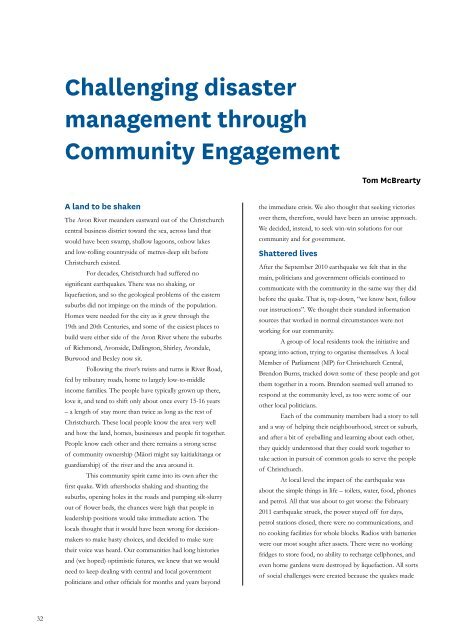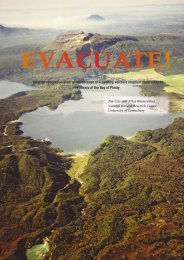Download Tephra Volume 23 (PDF, 1.33MB) - Ministry of Civil ...
Download Tephra Volume 23 (PDF, 1.33MB) - Ministry of Civil ...
Download Tephra Volume 23 (PDF, 1.33MB) - Ministry of Civil ...
Create successful ePaper yourself
Turn your PDF publications into a flip-book with our unique Google optimized e-Paper software.
Challenging disaster<br />
management through<br />
Community Engagement<br />
Tom McBrearty<br />
A land to be shaken<br />
The Avon River meanders eastward out <strong>of</strong> the Christchurch<br />
central business district toward the sea, across land that<br />
would have been swamp, shallow lagoons, oxbow lakes<br />
and low-rolling countryside <strong>of</strong> metres-deep silt before<br />
Christchurch existed.<br />
For decades, Christchurch had suffered no<br />
significant earthquakes. There was no shaking, or<br />
liquefaction, and so the geological problems <strong>of</strong> the eastern<br />
suburbs did not impinge on the minds <strong>of</strong> the population.<br />
Homes were needed for the city as it grew through the<br />
19th and 20th Centuries, and some <strong>of</strong> the easiest places to<br />
build were either side <strong>of</strong> the Avon River where the suburbs<br />
<strong>of</strong> Richmond, Avonside, Dallington, Shirley, Avondale,<br />
Burwood and Bexley now sit.<br />
Following the river’s twists and turns is River Road,<br />
fed by tributary roads, home to largely low-to-middle<br />
income families. The people have typically grown up there,<br />
love it, and tend to shift only about once every 15-16 years<br />
– a length <strong>of</strong> stay more than twice as long as the rest <strong>of</strong><br />
Christchurch. These local people know the area very well<br />
and how the land, homes, businesses and people fit together.<br />
People know each other and there remains a strong sense<br />
<strong>of</strong> community ownership (Māori might say kaitiakitanga or<br />
guardianship) <strong>of</strong> the river and the area around it.<br />
This community spirit came into its own after the<br />
first quake. With aftershocks shaking and shunting the<br />
suburbs, opening holes in the roads and pumping silt-slurry<br />
out <strong>of</strong> flower beds, the chances were high that people in<br />
leadership positions would take immediate action. The<br />
locals thought that it would have been wrong for decisionmakers<br />
to make hasty choices, and decided to make sure<br />
their voice was heard. Our communities had long histories<br />
and (we hoped) optimistic futures, we knew that we would<br />
need to keep dealing with central and local government<br />
politicians and other <strong>of</strong>ficials for months and years beyond<br />
the immediate crisis. We also thought that seeking victories<br />
over them, therefore, would have been an unwise approach.<br />
We decided, instead, to seek win-win solutions for our<br />
community and for government.<br />
Shattered lives<br />
After the September 2010 earthquake we felt that in the<br />
main, politicians and government <strong>of</strong>ficials continued to<br />
communicate with the community in the same way they did<br />
before the quake. That is, top-down, “we know best, follow<br />
our instructions”. We thought their standard information<br />
sources that worked in normal circumstances were not<br />
working for our community.<br />
A group <strong>of</strong> local residents took the initiative and<br />
sprang into action, trying to organise themselves. A local<br />
Member <strong>of</strong> Parliament (MP) for Christchurch Central,<br />
Brendon Burns, tracked down some <strong>of</strong> these people and got<br />
them together in a room. Brendon seemed well attuned to<br />
respond at the community level, as too were some <strong>of</strong> our<br />
other local politicians.<br />
Each <strong>of</strong> the community members had a story to tell<br />
and a way <strong>of</strong> helping their neighbourhood, street or suburb,<br />
and after a bit <strong>of</strong> eyeballing and learning about each other,<br />
they quickly understood that they could work together to<br />
take action in pursuit <strong>of</strong> common goals to serve the people<br />
<strong>of</strong> Christchurch.<br />
At local level the impact <strong>of</strong> the earthquake was<br />
about the simple things in life – toilets, water, food, phones<br />
and petrol. All that was about to get worse: the February<br />
2011 earthquake struck, the power stayed <strong>of</strong>f for days,<br />
petrol stations closed, there were no communications, and<br />
no cooking facilities for whole blocks. Radios with batteries<br />
were our most sought after assets. There were no working<br />
fridges to store food, no ability to recharge cellphones, and<br />
even home gardens were destroyed by liquefaction. All sorts<br />
<strong>of</strong> social challenges were created because the quakes made<br />
32

















